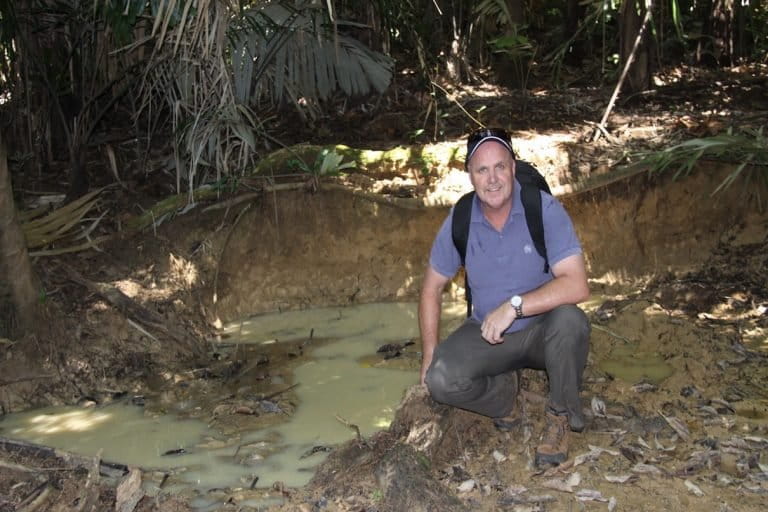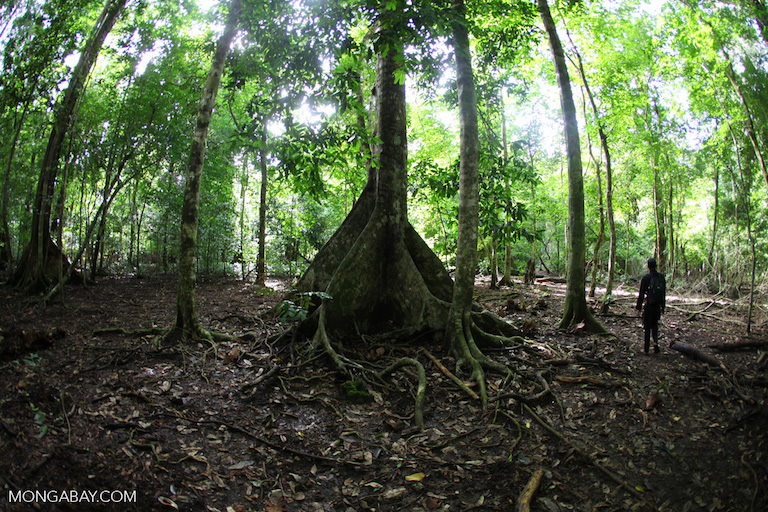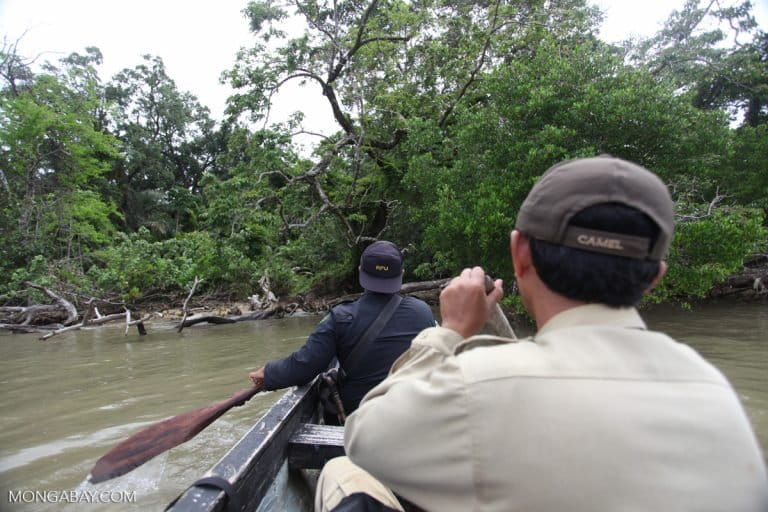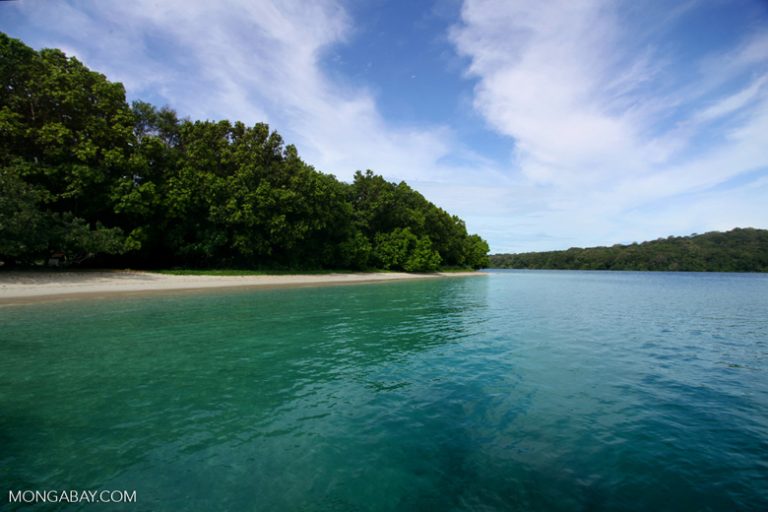- Javan rhinos are so cryptic and elusive that they are difficult to study, despite the entire species being confined to a single site.
- Camera traps are giving researchers new insights into the species’ behaviors and environmental needs.
- Steve Wilson, a doctoral student working on a dissertation about Javan rhinos, explains some of these new findings — and how novel research methods might help guide conservation strategies.
How much can we learn about a species that is rarely ever spotted by humans?
The Javan rhinoceros (Rhinoceros sondaicus) is among the rarest and most cryptic of mammal species. Although its entire remaining population is now confined to a single park in Indonesia, many aspects of these elusive animals’ lives remain almost completely unknown to science: how do they communicate, how do they find mates, what sort of social hierarchies do they observe?
Modern research tools like camera traps are starting to give some clues to these mysteries.
“You can’t beat direct observation,” says Steve Wilson, a doctoral student at the University of Queensland who is currently working on a dissertation about Javan rhinos. Still, he explains, images and audio clips are already giving researchers tantalizing new glimpses of the day-to-day lives of the park’s rhinos.
Ujung Kulon National Park — the Javan rhino’s final stronghold — is equipped with 120 cameras capable of recording both sound and imagery. As part of his research, Wilson has been able to conduct audio and visual analysis of 45 clips provided by park authorities. Following in the footsteps of pioneering researchers like the Schenkel family, Wilson is working to catalogue and understand the noises made by a species generally considered to be the least vocal of all rhinos.
Wilson recently stopped by Mongabay’s podcast, the Mongabay Newscast, to share his thoughts to share his thoughts on how insights from camera traps — as well as other research currently being undertaken in Ujung Kulon — are helping scientists understand more about the Javan rhino’s current status, and can perhaps offer guidance on how to help make sure the species has a future.

Mongabay: What can you tell us about the threats to the species, and what is their conservation status right now?
Steve Wilson: Their conservation status is they’re critically endangered. We know that there are currently 67 animals remaining.
What are their threats? They are suffering from a range of threats. The key threat is there is only one remaining population in one national park, so obviously that escalates and expands the whole range of threats around them.
So there’s a number of in situ challenges they face. One is human encroachment. Java, Indonesia, is the most populated island on the planet, so you’re talking 143-plus million people. There’s not a lot of good habitat left in the landscape and it’s been very fortuitous that Ujung Kulon, the national park, which is right on the tip of west Java still remains. It’s actually one of the last remaining patches of lowland rainforest left in Java, which is amazing.
Another threat is its location in the world. You would remember as a child Krakatoa being talked about — the volcano that erupted just [west] of Java in 1883, which sent successive tsunamis and scattered a whole heap of ash and debris over large parts of Indonesia. Of course, that impacted on the landscape there, wiped out a lot of people and no doubt would’ve impacted on rhinos at the time. And we suspect that it actually impacted on the local vegetation. So one of the challenges right at this point in time is that there is a native palm that is called called arenga palm, arenga obtusifolia, which is a very dominant species that has quite invasive qualities. It outcompetes a lot of the natural food plants for rhino, and it’s currently infesting around 18,000 hectares of their habitat, which is quite a threat.
You’ve done numerous research trips to Ujung Kulon national park, correct? Have you actually encountered a Javan rhino in the flesh?
Only fleeting, not properly. I’m very fortunate that I have all these camera videos of rhinos so I get to see them in the comfort of my own home. But no, I haven’t seen a rhino really clearly. And I certainly have not been able to get a good photo at this point in time. That’s certainly on my bucket list to do, yes.
Understandably. It must be difficult to research a species that’s so elusive. But camera traps are changing that.
They’re certainly helpful. They’re certainly not perfect, because obviously totally relying on an animal moving and behaving in front of a camera trap has its limitations. They currently occupy an area of about 30,000 hectares, so when you’ve only got 67 animals, they’re widely dispersed. So there’s a bit of an art in actually setting up the cameras in areas where you believe that they’re going to move.
There was a study done in 2013 where they intensively used cameras across Ujung Kulon and I think they got something like 13,000 clips of animals, but only about 1,000 out of those were actually of rhinos. So the strike rate is quite low. But certainly, it gives you insight.

So we’ve got three recordings to listen to today. So these were made by the camera traps equipped with microphones, and this is just the audio strip from the video.
That’s correct. There are 120 cameras that are set up across the rainforest, and every month the rangers and the rhino protection staff go out and collect the memory cards out of all cameras. Eventually some of those clips come through to me, which is fantastic.
Initially, I was fortunately given 45 30-second clips of rhinos. And pretty soon we realized that we were also able to identify these vocalizations, which we were a little surprised by.
I was actually looking more into just general behavior, and where they were behaving and what they were doing in the forest or in the wallow.
We’re starting to pick up the variations in the vocalization and begin to start to try and decipher what are actually some of these things doing and what are they meaning. Out of the 45 videos we originally looked at, we were able to capture 26 recorded vocalizations. And of those 26 recordings, we broke them up into seven vocal descriptors.
And since we’ve done that I’ve been very fortunate to receive another, much larger dataset of camera footage. I’ve got well over 300 camera clips of rhinos. Not only vocalizing, but doing a whole range of other behaviors. We’ve also been able to sort of justify some of our early descriptions and thinking, because we’ve had a larger dataset to compare, which has been really good.
Let’s take a listen to these recording here. We’ve got one that’s a mother and baby rhino together. What can we hear? What should we be listening for?
The vocal you’ll hear is called a bleat, and it’s a vocal delivered by the calf. These rhinos follow their mothers around the forest, and that’s through the day and through the night, so if they got split up they’re able to contact and recall to one another. And it’s quite interesting, and it’s a repeated vocal. It’s not a strong vocal, it’s very faint, but it’s very bleat-like, and we’ve honored the name bleat because that is how it was described by some of the early researchers.
It’s essentially a contact call — it’s short, it’s clear, it’s often repeated and it tends to imply urgency or uneasiness. So, for example, the calf’s lost sight of its mother so it will call and follow up. And often the female or cow will respond with what’s called a sigh, which is just like how a human would sigh. It’s quite a heavy sigh. It’s a response call, it’s an exhaled vocal, and it’s essentially used as an acknowledgement by the female in response to the calf bleats. The calf will repeat this bleat and then the cow will just give a gentle sigh, and it’s just an acknowledgement, OK, I’ve found you, you’re here.
So you can often sense the emotion in the call. It’s quite interesting.
We also have one here that’s just a calf call.
Yep, that’s right, that’ll be just a repeated bleat. It usually has a very short duration, it lasts less than half a second or so, and it’s repeated. Again, it’s just, “I’m here, this is where I am, mum.” It’s that type of call. And it’s interesting — we believe the male calves produce a slightly deeper-sounding bleat than the females. So we’ll probably be able to, maybe, ultimately discriminate between males and females.
And our final recording here is called the Flehmen response.
Actually it’s not a vocalization. A Flehmen response is what many carnivores and many herbivores respond to when they are trying to ascertain the reproductive state of the opposite sex. It’s sort of a grimace, they actually open their mouth and the tongue often hangs out a bit, and basically they are analyzing the scent
For example, if you’ve got a cow sitting in a wallow and a male rhino approaches the wallow, he’ll often pant as he approaches the female. Sometimes he may touch the female very gently, and he will be tasting her scent and he’ll be trying to assess her reproductive state. If, for example, she was a female in heat, he would potentially get aroused and want to mate with the female. Or the female might respond with what we call a long hiss, which is a single ear-piercing call. It’s very firm and it basically says, “No, I’m not interested,” or, “No, I’m with calf,” or “I’m not reproductive.”

So what new insights have you gained about Javan rhinos’ social behavior and habitat use as a result of these recordings?
Because we’re so reliant on camera trap footage, you can never really have enough data. The rhino footage tends to be in 30-second cycles, so while the animal’s in view it will keep recording. And what is useful is that it gives you the time of day in the data. So you know it’s the 10th of October, 4 in the afternoon. And you can actually see from the image, OK it’s raining, or it’s in a clearing or it’s right in forest country, or they might be sitting in a wallow or in a river or wherever it is.
So you can get that sort of basic information. But we’re probably very light on knowledge of social structure and certainly reproductive behavior. Because I suspect, just like many of the other rhino species, the reproductive game is quite vigorous for them. They are very active, they chase each other a lot, can be quite violent. And also we don’t have a clear understanding of whether the male rhinos actually form dominance hierarchies.
Certainly, Javan rhinos communicate in a number of ways. They communicate via vocalizations and also they’ll communicate via olfactory signals — in other words, they will spray urinate, they will deposit their scent on vegetation and on the ground — and by dung deposits. When they deposit dung, they are clearly communicating information about their individual identity, and ideally this may generate investigation from another rhino. For example, if you’re a female in estrus you would want to follow up with the male if you presume that he was dominant.
There’s really interesting information that needs to be deciphered, and over time that’s something we’ve just go to try and work out.
The other interesting thing is obviously in a very tropical rainforest environment, the dung doesn’t last very long, so the rangers and the rhino protection staff get very excited when they find fresh rhino dung because the can actually collect DNA from it. So far, we’ve collected around 19 different individual rhinos, so we’re actually building a bit of a genetic picture of how diverse the population is after it has been isolated and trapped in that one location for so long.
While we haven’t got the full spectrum of what rhinos are out there in terms of their DNA, it’s interesting that there is still a little bit of diversity in there, which is promising.

What are you hoping to learn more about through this research?
Well, ideally — and it’s been talked about for many years now —with only a single population, the need to have a second back-up and insurance population is very important.
But one of the challenges in the modern world is where can you move some rhinos to a habitat that’s safe, where they’re not going to get impacted by human encroachment or poaching pressure and all those current classic challenges that many rhino species face? So having an understanding of the rhino’s ecology is very important.
For example, we know that rhinos have a requirement to wallow. They like to roll in the mud, or at least cover themselves in water and in muddy conditions, because they need it for thermal regulation, they need it to keep cool, they need it to have a coating of mud to reduce the impacts of biting insects, and all of that.
But also we know that if a wallow is of good size and has good mud and a good ability to sustain itself for a long period of time, these are prime sites, and more than one rhino may visit that wallow. So that’s valuable information — for example, in a perfect world, where we’ve got too many rhinos in Ujung Kulon and we need to move some to a new site. Well, clearly we know now that wallows are a critical component — for them to live, to use, and also as a communication site. So that’s a fundamental basic understanding of one component of their ecology. You need to provide wallowing sites.
Well, just to wrap this conversation up, I’d love to hear what the conservation implications are of these insights? For instance, could they help shape decisions about which animals are the best candidates for relocation to a new habitat, if that plan were to ever get under way? Or could these recordings guide conservationists in looking at potential relocation sties? And do you feel like Indonesian authorities are open to taking this kind of information into consideration?
The authorities are very supportive and they’re very interested in any new information we can get.
One interesting thing is that there’s been some work done on black rhino dung and what they’ve found is that when the dung is deposited, it’s still producing scent signals over 30 days later. And there’s a school of thought that using dung deposits could help calm, and also help arouse curiosity in, animals that may be under stress. So, for example, I could see quite viable opportunities in the future to move animals to a new site, and if you could collect some fresh dung you would be able to deposit that dung at the new site and that would arouse curiosity in those newly translocated animals, and would create potentially create a less stressful environment or stimulate them in a way.
These are all little components of understanding their communication and how to help keep animals calm when you move them to other sites. It could be a way of stimulating low reproductive animals to maybe become more aroused and reproductively viable, because it’s all about that stimulation.
I would be quite pleased if some of the work that we’ve been doing could provide some information that really helps future conservation of the animals. They are severely threatened, and it’s a high-risk game when you’ve only got one population in a part of the world that’s got a lot of pressure being applied to its habitat.

Editor’s note: this interview has been edited for length and clarity.
FEEDBACK: Use this form to send a message to the author of this post. If you want to post a public comment, you can do that at the bottom of the page.